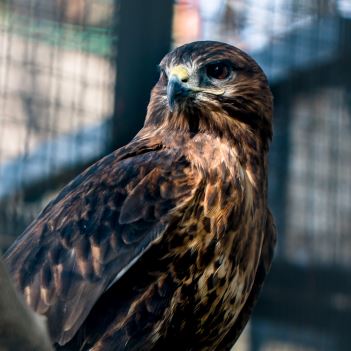Geographic Range
Aquilua heliaca can be found throughout southern Europe from Greece to southern Russia. Here it can be found as far south as a line drawn from Cyprus to northwest India, and as far east as Central Siberia. It can also be found sparsely in Spain. In winter it migrates to northeast Africa (from Egypt to Kenya), India, and southeast China also,you can see them in America and asia in iran you can see them in western part of iran.
Habitat
The Imperial Eagle tends to live in forests, where it will build a huge, conspicuous nest in an isolated tall tree. Old forests, and the forests in mountains, hills, and along rivers are all common habitats. It has, however, also been known to live in steppes, open landscapes, agricultural areas, and even semideserts. Imperial eagles hunt in open fields or wetlands. During migration, a variety of habitats are used, though they seem to prefer to winter in wetlands.
Physical Description
The Imperial Eagle is the second largest eagle to reside in Europe. It can grow to a length of about 0.92 meters. It can have a wingspan approaching 2.14 meters and have a mass of about 3.6 kilograms. Adults are black-brown in color. They have a pale golden crown and nape, and a grey base that extends to the tail. They also have very apparent white "braces" on their scapulars. Juveniles are paler and more variegated than the adults. They are yellow-brown with rump, wing, and tail patterns similar to the patterns of the Lesser Spotted, pale Spotted, Tawny and Steppe eagles. They are distinguished from these eagles, however, by the bolder streaks on their under-wings and body, the lack of a pale band under the wing-coverts, and their larger and more majestic build. Both the juveniles and adults have noticeably protruding head and long, parallel-edged wings. Like other eagles, they have strong legs and feet. Their feet include long, curved talons that they use to seize, kill and carry their prey. They also have large eyes that are located slightly to the side of the head. These eyes provide them with extremely keen eyesight, allowing them to spot prey from high in the air.
Reproduction
Imperial Eagles are ready to breed for the first time when they are about four years old. When they reach this age, they find a mate whom they stay with for life. If one happens to die, however, the other will usually find a new mate and breed the next year. Every pair will build a nest, called an eyrie, in the top of a tree. These nests are generally made mainly with sticks, and are used only during the spring and summer months. Females will generally lay two eggs a year. Sometimes, however, they will lay three eggs, and on a few rare occasions they will lay four. These eggs have to be incubated for about forty-three days before they can hatch, and both parents will participate in the incubation. Even though two eggs are usually hatched, it is unusual for both eaglets, or baby eagles, to survive. One is usually born a couple days earlier than the other. This older, larger eaglet eats more than its share of food, and will repeatedly attack, often killing, the younger one. The young eagles are ready to fly when they are sixty days old. They stay near the nest, however, for an additional two weeks, and continue to be fed by the mother until they are ready to hunt for themselves.
Behavior
The Imperial Eagle is, for the most part, a solitary species. The one exception to this is seen during migrations. Each eagle will leave individually, but there is a tendency to gather into loose flocks of ten or more once the journey has begun. Since it is a loose flock there isn't much organization to it, and the individuals are free to come and go as they please. During migration, the Imperial Eagle has been known to travel up to 8000 km in about six weeks to reach their new quarters.
When the Imperial Eagle flies, it soars on level wings. It glides through the air with slightly lowered primaries, and beats its wings with a heavy, flopping action. Its behavior tends to be rather sluggish over long periods of time, but when hunting or in high flight it can move remarkably fast.
Food Habits
The Imperial Eagle, like other birds of prey, is a carnivore. Its main source of food is small mammals, such as rabbits and susliks (ground squirrels in the genus Spermophilus). It will also eat reptiles, including some poisonous snakes, and other birds, such as young magpies, waders, and ducks. It has been known to feed on some carrion as well, carrying off lambs that were already dead. It generally hunts by slowly flying around the open areas near the forest where it resides, staying just above the treetop level, and scanning for prey. Its excellent eyesight makes spotting prey easy. When it sees a suitable prey item it will drop down on it, using its talons to kill and carry the prey. It will also, on a few occasions, perch high on a tree near the edge of the forest, and drop on its prey from there. Imperial Eagles are beneficial to farmers and ranchers because they feed on rabbits and other small mammals. By eating these animals, the Imperial Eagle reduces their numbers, and thus reduces the damage they can do. This eagle also feeds on venomous reptiles, many of which have been known to cause serious harm to humans. Although rare, Imperial Eagles have been known to attack humans who come too close to their nests. They may dive at a person who gets too close and strike at them with their talons.
Conservation Status
The Imperial Eagle is classified as endangered at the European level, and vulnerable at the global level. There are several threats to its survival, and habitat alterations are probably the most critical. Several kinds of forestry operations in their breeding areas can seriously hurt its ability to survive and reproduce. These operations include, but aren't limited to, the cutting of forests for reafforestation with alien species, cutting of large, old trees in forests and along forest edges, and logging disturbances. Several other types of human disturbances can also be major limiting factors. The Imperial Eagle is a very sensitive species, and can easily be hurt by both intentional and unintentional interference. An example of intentional interference is hunting. Imperial Eagles are often shot during migrations. Examples of unintentional interference include the eagles ingesting poisons meant to control other species and flying into power lines, electrocuting themselves.

